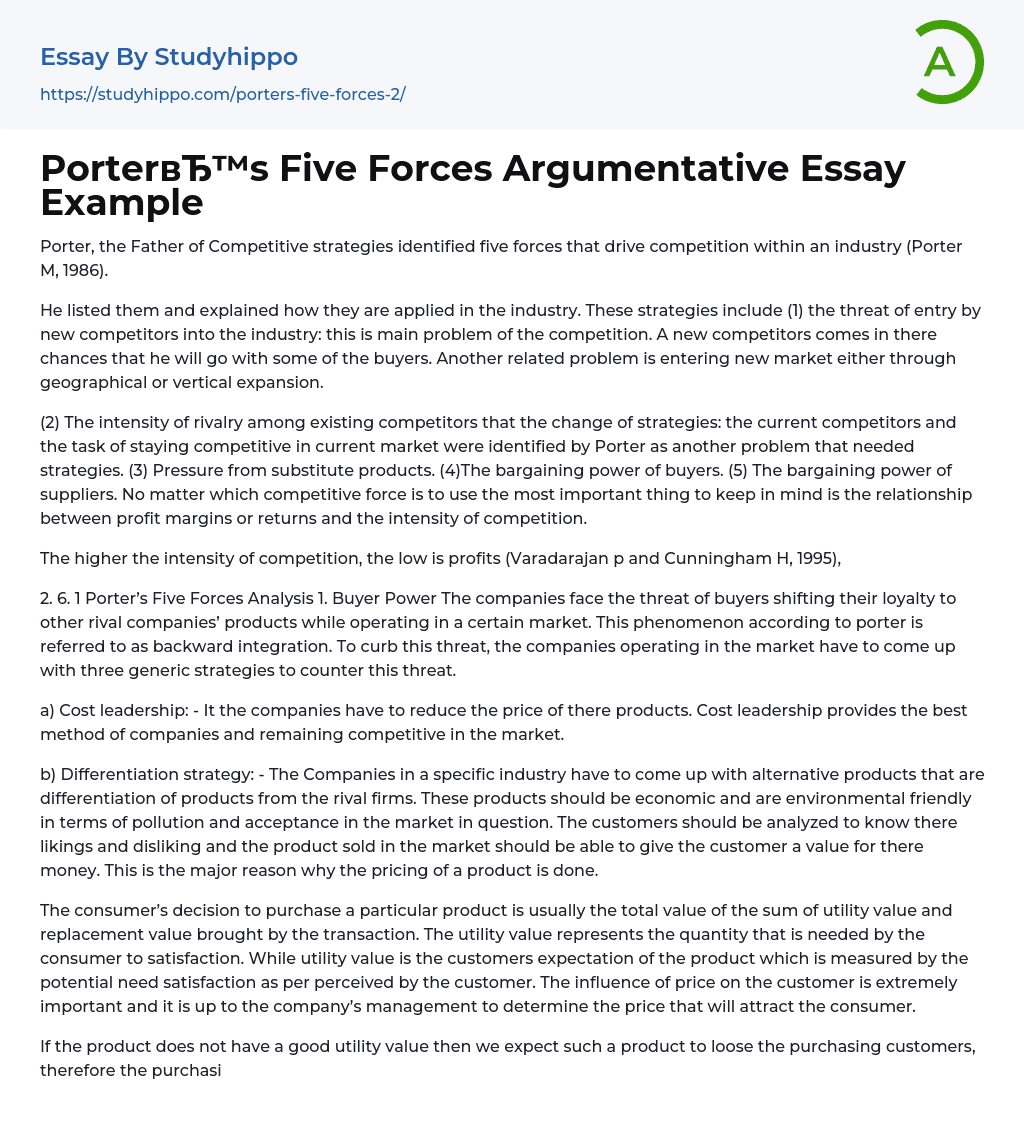Porter, recognized as the Father of Competitive strategies, delineated five forces that prompt competition within industries. In 1986, he expounded on how these strategies could be applied in the industry, including: (1) competition issues arising from new competitors entering an industry and their endeavors to enter new markets through geographic or vertical expansion which may result in loss of buyers; (2) staying competitive with current rivals and dealing with intense rivalry among them that may lead to a change of strategies; (3) pressure from substitute products; (4) bargaining power of buyers; and (5) bargaining power of suppliers. Regardless of the competitive force used, it's crucial to consider profit margins/returns in relation to intensity of competition. Varadarajan p and Cunningham H (1995) found that as competition increases profits decrease. Buyer Power is identified as a key factor companies face when consumers switch loyalty to rival b
...rands while operating in specific markets based on Porter’s Five Forces analysis.According to Porter, backward integration is a phenomenon that must be addressed by companies in order to counter threats in the market. To do so, they must implement cost leadership and differentiation strategies. Cost leadership entails reducing product prices as the best means of remaining competitive, while differentiation strategies involve creating alternative products that are both environmentally friendly and economically viable. By analyzing customers' preferences, companies can ensure customer satisfaction and value for money. Pricing is therefore critical because consumers' decisions to purchase products depend on their utility and replacement values brought by the transaction. The utility value refers to the quantity that satisfies the consumer while perceived need satisfaction represents customer expectations of the product's benefits. Management should determin
an attractive price for consumers since pricing significantly influences purchasing power. Failure to provide sufficient utility value may result in a loss of purchasing customers. Additionally, supplier power poses a significant threat since suppliers can control material prices through cartels or strict controls that negatively impact industry performance.Companies must be cautious of strict labor laws and unionized employees, requiring them to treat their workers fairly and equitably. Some companies combat supplier power by expanding their supply chain or implementing generic strategies like raising product prices to compensate for raw material costs – known as differentiation strategy. Another way to strengthen the business is through focus. Due to high material expenses, some companies concentrate on improving product quality and can then increase prices without negatively affecting customers – a differentiation-focused strategy. Additionally, new businesses face barriers when entering the market with similar products, which could cause established companies to lose profits and market share. To counteract this threat, firms have adopted cost leadership approaches that reduce production expenses while increasing operational efficiency resulting in lower-priced products with maintained profits; dissuading potential competitors from entering the market (Staw et al., 1983). Industry rivalry poses another force that threatens businesses since competitors may take over the market share. Companies should reduce prices temporarily when confronted with such threats but return back to normal once competitors exit the segment of the market they operate in.In order to safeguard their patents and copyrights, companies must ensure that their headquarters are not accessible to outsiders and provide adequate compensation to employees in order to prevent them from leaving for competing firms. Economists assert that the risk of substitutes arises when a
substitute's price is likely to impact demand for a particular good. Due to the price elasticity of goods, businesses face an arduous task of maintaining sustainability in the future. To overcome this challenge, they adopt differentiation as a key strategy in their frameworks, thereby reducing the threat's strength and danger and fostering customer loyalty towards the uniqueness of their products.
- Chief Executive Officer essays
- Convenience Store essays
- Firm essays
- Training And Development essays
- Unilever essays
- Variable Cost essays
- Virgin Group essays
- Bargaining essays
- Entity essays
- Pest analysis essays
- Finance essays
- International Business essays
- Macroeconomics essays
- Barriers To Entry essays
- Microeconomics essays
- Pricing essays
- Profit essays
- Consumerism essays
- Export essays
- Free Trade essays
- International Trade essays
- Compensation essays
- Monopoly essays
- Trade essays
- Industry essays
- Warehouse essays
- Economic Development essays
- Economic Growth essays
- Inflation essays
- Taxation essays
- Central Bank essays
- Monetary Policy essays
- Economy essays
- Gross Domestic Product essays
- Recession essays
- Capitalism essays
- Economic System essays
- Materialism essays
- World economy essays
- American Dream essays
- resources essays
- Max Weber essays
- Employment essays
- Minimum Wage essays
- Unemployment essays
- Human Development essays
- Income Inequality essays
- Economic Inequality essays
- Money essays
- Financial Accounting essays




